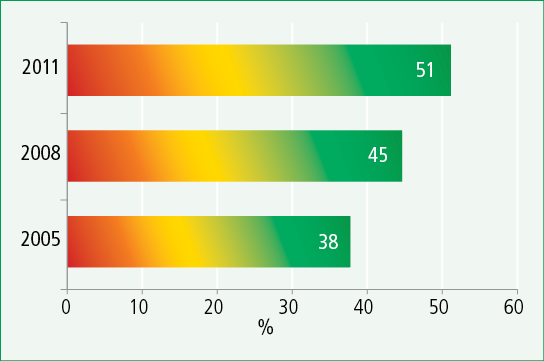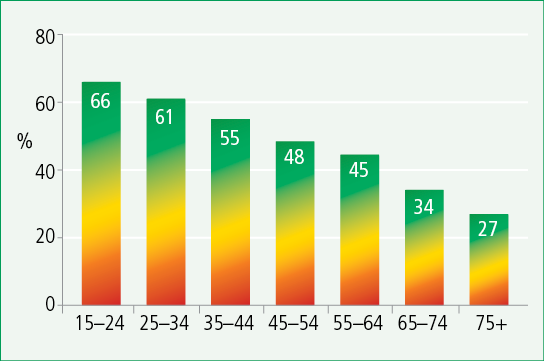Same-sex couple families in Australia
September 2016
Download Research snapshot
Introduction
How many same-sex couple families are there in Australia?
Australian families are characterised by increasing diversity – including a rise in the number of same-sex couple families.
The Australian Census started collecting information on same-sex couples in 1996. According to the 2011 Census, there were 33,700 same-sex couples in Australia, a rise of 32% since 2006 (ABS, 2012). Same-sex couples accounted for 0.7% of all couple households in 2011, compared with 0.6% in 2006 and 0.3% in 1996.
The Australian Bureau of Statistics (ABS; 2016) estimated that there were 48,000 same-sex couples in June 2015, accounting for 0.9% of all couple families. ABS noted that the apparent rise might partly reflect an increasing willingness for same-sex couples to disclose their relationship. It could also be the case that same-sex partners are now more prepared to form a couple household, rather than to maintain separate homes.
Of the same-sex families in 2011:
- 52% were male couples; and
- 48% were female couples.
Same-sex partners were most commonly aged 35–44 years (representing around 30% of all such partnerships) and tended to be younger than opposite-sex partners.
Of same-sex couples, 12% had children, including adult children, living with them. (In the broader population the figure is over 50%.) A significantly higher proportion of female couples than male couples had children living with them (22% and 3% respectively).
An Australian Institute of Family Studies report (Dempsey, 2013) stated that approximately 11% of gay men and 33% of lesbians in same-sex relationships have children. Higgins (2002) noted that children in same-sex parented families may have been raised from birth by a co-parenting gay or lesbian couple, raised by a single parent, or conceived in the context of previous heterosexual relationships.
Same-sex parented families and child wellbeing
Overall, the evidence does not support the view that same-sex parented families are harmful to children, with a review of Australian and international research (Dempsey, 2013) concluding that children in same-sex parented families do as well emotionally, socially and educationally as those in opposite-sex parented families. Further support for this came from an Australian study by Crouch, Waters, McNair, Power, and Davis (2014), which involved a convenience sample of 500 children of same-sex attracted parents, and found that they did just as well on a range of measures of child health and wellbeing, compared to children in broader population samples.1
In some of the studies reviewed by Dempsey (2013), selected measures of wellbeing were more positive among children in same-sex parented families compared to other children. However, a key finding of the study by Crouch et al. (2014) was that parents with more perceived stigma related to their same-sex attraction (e.g., being the subject of gossip, social exclusion) provided a poorer assessment of their child’s outcomes in physical activity and emotional development, and poorer family cohesion compared with other same-sex attracted parents. That is, the experience of stigma related to having same-sex parents, which might include experiences of bullying or social exclusion, can be a risk factor for the wellbeing of children.2
Attitudes towards same-sex relationships
Community views about same-sex couples appear to have changed significantly over the past decade. The Household, Income and Labour Dynamics in Australia (HILDA) Survey3 has collected data on the issues relating to equal rights of same-sex couples and opposite-sex couples in some survey waves. In 2005, 2008 and 2011, respondents age 15 years and over were asked to rate their level of agreement or disagreement with the statement “Homosexual couples should have the same rights as heterosexual couples do” on a scale ranging from (1) strongly disagree to (7) strongly agree.
Figure 1 shows the proportion of the respondents who indicated some level of agreement (i.e., ratings of 5–7) with the statement across the three years.
Figure 1: Percentage of respondents who indicated their agreement with equal rights of same-sex and opposite-sex couples in 2005, 2008 and 2011

Note: Percentages based on weighted data. Agreements refer to the ratings of 5–7 on a scale from (1) strongly disagree to (7) strongly agree with the statement that homosexual couples should have the same rights as heterosexual couples.
Source: HILDA (2005, 2008, 2011)
- The support for equal rights between same-sex couples and opposite-sex couples has increased steadily from 38% in 2005, to 45% in 2008 to 51% in 2011.
- The proportion of respondents who neither agreed nor disagreed with the statement remained stable across the three time points, at 15–16%.
Women were more likely to endorse equal rights for same-sex couples. In 2011, 58% of women agreed with the proposition, compared with 44% of men.
Views on equal rights are inversely associated with age. Figure 2 shows the support for equal rights for same-sex couples was lower with each increasing age bracket. Two-thirds of the youngest age group (15–24 years) in 2011 indicated their support for equal rights, compared with just over one-quarter of the oldest age group (75+ years).
Figure 2: Percentage of respondents who indicated their agreement with equal rights of same-sex and opposite-sex couples by age group, 2011

Note: See note to Figure 1.
Source: HILDA (2011)
References
- Australian Bureau of Statistics. (2012). Same-sex couple families: Reflecting a nation. Stories from the 2011 Census, 2012–2013 (Cat. No. 2071.0). Canberra: ABS. Retrieved from <tinyurl.com/bubfrq7>.
- Australian Bureau of Statistics. (2016). Labour force, Australia: Labour force status and other characteristics of families, June 2015 (Cat. No. 6224.0.55.001). Canberra: ABS. Retrieved from <www.abs.gov.au/AUSSTATS/[email protected]/mf/6224.0.55.001#>
- Crouch, S.R., Waters, E., McNair, R., Power, J., & Davis, E. (2014). Parent-reported measures of child health and wellbeing in same-sex parent families: A cross-sectional survey. BMC Public Health, 14,635.
- Dempsey, C. (2013). Same-sex parented families in Australia (CFCA Paper No. 13). Melbourne: Australian Institute of Family Studies. Retrieved from <aifs.gov.au/cfca/publications/same-sex-parented-families-australia>
- Higgins, D. J. (2002). Gay men from heterosexual marriages: Attitudes, behaviours, childhood experiences, and reasons for marriage. Journal of Homosexuality, 42(4),15–34.
1 There are methodological challenges in answering questions about how children’s wellbeing compares for those in same-sex parented families. Challenges arise in particular because samples of children with same-sex parents tend to be very small, and are often biased. Making valid comparisons while also taking account of differences in family socio-economic status, parenting, and instability of family relationships can therefore be difficult. As a consequence, this continues to be considered a controversial area of research (see Dempsey, 2013).
2 The negative impacts of homophobia and prejudice, including the distress experienced by same-sex attracted people as a result of stigma and discrimination, and the mental health consequences of social exclusion, are discussed by the American Psychological Association <www.apa.org/about/gr/issues/lgbt/marriage-equality.pdf> and the Australian Psychological Society <www.psychology.org.au/Newsandupdates/22Dec2011/ >.
3 The HILDA project was initiated and is funded by the Australian Government Department of Social Services (DSS) and is managed by the Melbourne Institute of Applied Economic and Social Research. The findings and views based on these data are those of the authors and should not be attributed to either DSS or the Melbourne Institute.